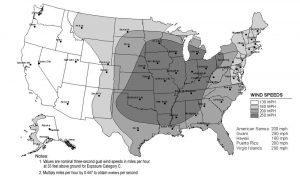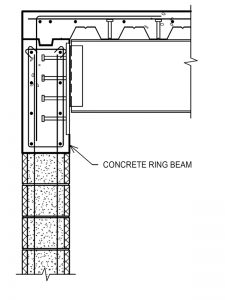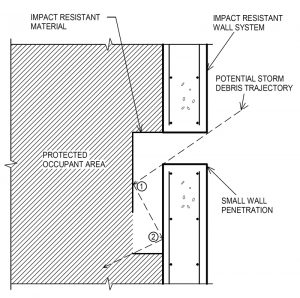Key Considerations and Lessons Learned
Recent media coverage has highlighted the devastation associated with tornado outbreaks in many urban and suburban areas. Rapid population growth and urban sprawl in many cities within the central United States have increased the number of structures located within the potential path of these dangerous storms. Tornadoes generate high winds and extreme loads that are significantly higher than typical building design loads.
When tornadoes strike in populated areas, the cost can be devastating in terms of injuries, loss of life, and damage to property. The destructive tornado that struck Joplin, Missouri, in May 2011 injured 1,150 people, killed 158, and caused an estimated $2.8 billion in damage – one of the most expensive on record. In March 2020, a pair of devastating tornadoes passed through the Nashville, Tennessee, area, killing at least 24 people and severely damaging or collapsing hundreds of structures.
In 2014, the second edition of ICC 500, Standard for the Design and Construction of Storm Shelters, was co-published by the International Code Council (ICC) and the National Storm Shelter Association (NSSA). Starting with the 2015 International Building Code (IBC), certain structures are required to be designed with ICC 500-compliant community tornado shelters. This article provides clarity on when an ICC 500 tornado shelter is required per the IBC and shares lessons learned to help practicing structural engineers design safe and effective tornado shelters.
Tornado Rating Scale
It is helpful to have a baseline understanding of the Enhanced Fujita (EF) scale to comprehend the requirements of ICC 500. Within the EF scale, tornadoes are rated from EF0 to EF5 based on observed damage that is then correlated back to an estimated three-second gust wind speed. EF0 tornadoes start at an estimated wind speed of 65 mph and can cause damage, including loss of roof covering materials, gutters, awnings, or siding. An EF3 tornado has estimated wind speeds ranging from 135 mph to 165 mph, and damage may include failed roof structures and multiple collapsed walls. The most devastating tornadoes are rated EF5 and carry estimated wind speeds of 200+ mph. These tornadoes can cause complete destruction of engineered, well-constructed structures.
When is a Shelter Required?
Per IBC 2015, Section 423, ICC 500 tornado shelters are required for structures located within the region of the country designated with a 250-mph shelter design wind speed (Figure 1) that meet one of the following criteria:
- The structure contains critical emergency operations such as 911 call stations, emergency operations centers, fire, rescue, ambulance, and police stations.
- The structure is classified as a Group E Occupancy, such as a K-12 school, with an aggregate occupant load of 50 or more.
Design Criteria and Systems
ICC 500 tornado shelters must be designed for several types of extreme loads. The design standard requires that tornado shelters be designed to sustain wind loads five to seven times higher than a similarly sized, non-shelter building located on the same site. The minimum roof live load for a tornado shelter is 100 psf, up to five times higher than a non-shelter roof.
Storm shelters must also be designed for debris hazard loads, such as wind-borne debris and laydown, rollover, and collapse loading. For wind-borne debris loading, ICC 500 requires that all components on the envelope of a tornado shelter with a 250-mph design wind speed be tested to resist a 15-pound sawn lumber 2×4 missile shot at a speed of 100 mph for vertical surfaces and 67 mph for horizontal surfaces. FEMA P-361, Third Edition, Part B8, is a helpful reference for practicing engineers to clarify debris impact loading and determine minimum wall and roof thicknesses that meet these requirements.
Another type of debris hazard load is laydown, rollover, and collapse loading; however, little code guidance is provided to assist practicing engineers when calculating the magnitude of these loads. Generally, these hazards are defined as structures or components that have a fall radius overlapping the footprint of the shelter. Based on the verbiage in ICC 500, structural engineers must rely on judgment to determine these significant and potentially catastrophic loads. At a minimum, it is recommended the shelter be designed for the weight of any laydown, rollover, or collapse hazard multiplied by an impact factor, the magnitude of which is left up to the engineer’s judgment. Without further code guidance, the authors believe it is prudent to consider an impact factor of no less than 2.0. Further guidance on this topic is being considered for inclusion in the 2020 version of ICC 500.
When determining the best structural system for a tornado shelter, the size of the shelter has a significant impact. For smaller shelters, such as those commonly located in municipal facilities with emergency operations functions, fully grouted concrete masonry unit (CMU) walls may be the most economical option. For these shelters, a roof system composed of structural steel beams and concrete-topped composite metal deck has proven to be cost-effective. However, designing connections to transfer the large roof beam reactions directly into the CMU walls can become difficult. Detailing a concrete ring beam around the perimeter of the shelter roof, integral with the CMU wall, has been a successful way to facilitate more effective steel beam connections to the walls (Figure 2).
For larger shelters, commonly located in K-12 schools, concrete walls are frequently required. A cost consultant should be engaged to provide preliminary cost estimates to help guide the decision regarding which type of concrete wall system would be most economical for a given project. Total precast concrete solutions can also be an economical solution for larger shelters; however, special detailing must be provided at the precast panel joints, and the diaphragm design and connections require careful coordination with the precast engineer. If pursuing this option, a precast manufacturer should be retained to consult on the project during the design phase.
Lessons Learned
Having experience with both municipal and educational projects, the authors’ firm has designed many ICC 500 storm shelters. As a result, the following list of lessons learned may help practicing engineers as they navigate through these provisions.
First, it is wise to purchase a copy of the ICC 500 standard with the commentary included and download a free copy of FEMA P-361, Design and Construction Guidance for Community Safe Rooms. Both documents provide helpful guidance and context for many of the provisions in ICC 500.
Overall Project
- Ensure the Owner engages a peer reviewer early, and ensure the architect builds time into the project schedule to account for the peer-review process. Within ICC 500, an independent peer review is required for all storm shelters that are mandated by IBC 2015. Reviews are required for structural, architectural, and MEP systems, and many times structural calculations are requested by the peer reviewer. Shelter peer reviews commonly take two to three weeks, and the authors have found success scheduling the peer reviews in conjunction with the 50% Construction Documents (CD) and 90% CD deadlines. A signed peer review report must be submitted to the authority having jurisdiction (AHJ) before the issuance of a building permit, so allowing adequate time for peer review is essential to maintaining the project schedule.
- Encourage the architect to clarify the occupant load for the storm shelter early. In essence, the occupant load requirements can be widely interpreted by AHJ’s for both municipal and educational projects, and the size of the shelter is significantly affected by that decision as the minimum size is dictated by occupant load.
- Encourage early study and comprehension of the Quality Assurance (QA) plan requirements by the full design team. ICC 500 requires that a QA plan be developed and included within the construction documents. This plan must identify all main wind force-resisting systems and wind-resisting components along with the observations, special inspections, and testing requirements for these elements. In addition to structural elements, there are architectural and MEP components that fall within the scope of the QA plan.
Structural
- Drawing organization is critical – separate storm shelter and non-shelter requirements on notes, special inspections, plans, and details to keep the shelter requirements clear.
- Provide an expansion joint around the perimeter of the shelter and avoid supporting elevated framing on top of single-story shelters.
- Include wall elevations for all perimeter shelter walls on drawings and closely coordinate all architectural and MEP penetrations. Check the capacity of opening jambs early, as jamb capacity often governs the design.
- Design the shelter for an internal pressure coefficient of GCpi = +/−0.55 when calculating wind loads, unless atmospheric pressure change (APC) venting is provided to justify an enclosed building coefficient of GCpi = +/−0.18. In the authors’ experience, providing APC venting is challenging and generally not relied upon.
Architectural/MEP Coordination
- Coordinate with the architect and MEP engineers to ensure missile impact test data has been obtained for all opening protective devices such as doors, windows, and louvers. If a qualified component is not available, then a baffling system must be provided; the design of this frequently falls within the structural engineer’s scope. See Figure 3 for a simplified depiction of a baffling system for a wall penetration; remember that the storm debris trajectory must hit two missile impact resistant surfaces before entering the protected occupant area.
- Coordinate with the architect and MEP engineers to ensure conduit, electrical boxes, fire extinguishers, and/or other components are not embedded in perimeter shelter walls such that they compromise the minimum wall thickness required to meet the impact resistance requirements.
- Coordinate with the mechanical engineer to determine if the shelter will be naturally or mechanically ventilated since this will affect the size and quantity of penetrations through the envelope of the structure.
Construction
- Develop a standard form to help guide contractors in submitting “Contractor’s Responsibility” statements; it is not common practice in many jurisdictions. ICC 500 requires that all contractors responsible for the construction, fabrication, or installation of any item listed in the QA plan submit a written statement of this responsibility that acknowledges the special requirements and quality control measures they will undertake. These written statements of responsibility must be submitted to the AHJ, the responsible design professional, and the Owner before the commencement of any work.
- Require a pre-construction meeting specifically for the storm shelter and include an agenda for this meeting within the project specifications.
- Ensure the third-party testing lab is engaged in all conversations related to storm shelter inspections early – they are the eyes and ears on-site in many cases.
- Require a partial-wall CMU mock-up before the start of overall construction if the shelter perimeter walls are CMU, as this generally results in a much higher quality of construction.
- Consider incorporating qualification-based selection criteria for certain key subcontractors to ensure prior experience with ICC 500. A contractor’s previous experience on an ICC 500 storm shelter increases the level of quality dramatically.
Summary
When working on a project with an ICC 500 tornado shelter, strive to engage clients early in discussions about storm shelter requirements. Encourage clients to build additional time into the project schedule for peer reviews and to plan for additional costs in the scope-to-budget phase. Costs associated with a more robust structure and foundations, specialty architectural and MEP components, and emergency MEP systems can add up quickly. Lastly, structural engineers should expect to help lead a more detailed coordination effort during the design and construction stages. Those steps, coupled with a thorough understanding of both ICC 500-2014 and IBC 2015, will aid in a smoother design and construction process resulting in a storm shelter capable of withstanding catastrophic weather events.■
Previous articles on ICC-500:
Tornado Shelters in Schools. Harris, STRUCTURE September 2016
Hurricane-Driven Building Code Enhancements. Knezevich et al., STRUCTURE July 2017
Tornado Debris and Impact Testing. Throop et al., STRUCTURE May 2018



